Windshield wiper motor
- Turn off the ignition
- Unplug the connector.
- Using the connecting wire, prepare the test procedure according to the following description.
- Use an external 12V continuous current source capable of carrying up to 10A minimum, or use battery voltage with a fuse.
1. Check the wiper motor in SLOW WIPER mode.
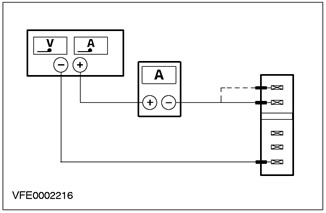
- Connect the positive terminal of the power supply to the positive terminal of the DMM.
- Connect the negative terminal of the power supply to pin 1 of the wiper motor.
- Connect the negative terminal of the DMM to pin 5 of the wiper motor. The wiper motor will operate at low speed.
Measure the current
Is the value on the DMM close to 1.5 A? If yes, go to step 2.
If not, INSTALL a new windshield wiper motor.
2. Check wiper motor in HIGH SPEED WIPER mode (drawing VFE0002216)
- Connect the positive terminal of the power supply to the positive terminal of the DMM.
- Connect the negative terminal of the power supply to pin 1 of the wiper motor.
- Connect the negative terminal of the DMM to pin 4 of the wiper motor. The wiper motor will operate at high speed.
Measure the current
Is the value on the DMM close to 2.2A? If yes, go to step 3.
If not, INSTALL a new windshield wiper motor.
3. Check wiper motor in OFF position
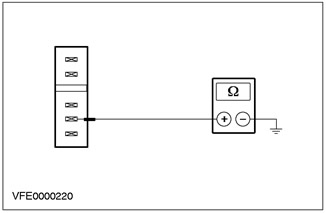
Measure the resistance at the windshield wiper motor, between pin 2 and the wiper motor housing.
Is the resistance less than 2 ohms? If yes, go to step 4.
If not, GO to step 4 and REPEAT this test step (If still not, INSTALL a new windshield wiper motor).
4. Check the OFF position function of the wiper motor.

- Connect the positive terminal of the power supply to pin 5 of the wiper motor.
- Connect the negative terminal of the power supply to pin 2 of the wiper motor.
- Connect the connecting wire to the wiper motor, between pin 1 and pin 3.
Determine state
Does the wiper motor move to the OFF position?
If so, the windshield wiper motor is OK.
If not, INSTALL a new windshield wiper motor.
Rear wiper motor
- Switch off the ignition.
- Unplug the connector.
- Using the connecting wire, prepare the test procedure according to the following description.
- Use an external 12V continuous current source capable of carrying up to 10A minimum, or use battery voltage with a fuse.
1. Check the wiper motor in the ON position.
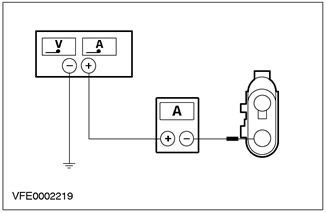
- Connect the positive terminal of the power supply to the positive terminal of the DMM.
- Connect the negative terminal of the power supply to the wiper motor housing.
- Connect the negative terminal of the DMM to pin 2 of the wiper motor. The wiper motor will operate.
Measure the current
Is the value on the DMM close to 1.5 A? If yes, go to step 2.
If not, INSTALL a new rear wiper motor.
2. Check the OFF function of the wiper motor
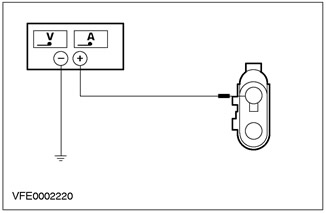
- Connect the positive terminal of the power supply to pin 1 of the wiper motor.
- Connect the negative terminal of the power supply to the wiper motor housing.
Determine state
Does the wiper motor move to the OFF position?
If so, the rear window wiper motor is OK.
If not, INSTALL a new rear wiper motor.
Relay
- Windshield Wiper Relay
- Rear window wiper relay
1. Check the relay contact is normal (closed position)
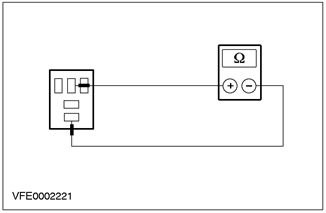
Measure the resistance across the relay between pin 3 and pin 4.
Is the resistance less than 1 ohm? If yes, go to step 2. If not, INSTALL a new relay.
2. Check the relay contact is normal (open position)
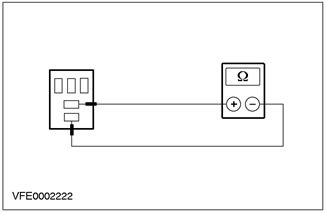
Measure the resistance across the relay between pin 3 and pin 5.
Is the resistance greater than 10 kΩ? If yes, go to step 3. If not, INSTALL a new relay.
3. Check the relay contact is active (closed position)
Using the connecting wire, prepare the test procedure according to the following description.
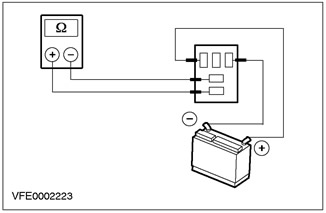
- Connect the positive battery terminal to pin 1 of the relay.
- Connect the negative battery terminal to pin 2 of the relay.
Measure the resistance across the relay between pin 3 and pin 5.
relay switches (with a distinct click), when battery voltage is applied and the resistance is less than 1 ohm?
If so, the relay is good. If not, INSTALL a new relay.
Wiper/Washer Switch
|
Functions to be tested |
Digital multimeter pins |
Switch position |
Targets |
|
INTERMITTENT CLEANING |
6 and 10 |
"one touch" |
more than 10 kOhm |
|
turned off |
more than 10 kOhm |
||
|
Intermittent cleaning |
less than 1 ohm |
||
|
low speed cleaning |
more than 10 kOhm |
||
|
high speed cleaning |
more than 10 kOhm |
||
|
7 and 9 |
"one touch" |
more than 10 kOhm |
|
|
turned off |
less than 1 ohm |
||
|
Intermittent cleaning |
less than 1 ohm |
||
|
low speed cleaning |
more than 10 kOhm |
||
|
high speed cleaning |
more than 10 kOhm |
||
|
1 and 6 |
"one touch" |
more than 10 kOhm |
|
|
turned off |
more than 10 kOhm |
||
|
Intermittent cleaning |
See adjustable intermittent cleaning |
||
|
low speed cleaning |
more than 10 kOhm |
||
|
high speed cleaning |
more than 10 kOhm |
||
|
ADJUSTABLE INTERMITTENT CLEANING |
1 and 10 |
1 |
1 kOhm |
|
2 |
10 kOhm |
||
|
3 |
20 kOhm |
||
|
4 |
30 kOhm |
||
|
5 |
40 kOhm |
||
|
6 |
47 kOhm |
||
|
"ONE TOUCH" |
6 and 9 |
"one touch" |
less than 1 ohm |
|
turned off |
more than 10 kOhm |
||
|
Intermittent cleaning |
more than 10 kOhm |
||
|
low speed cleaning |
more than 10 kOhm |
||
|
high speed cleaning |
more than 10 kOhm |
||
|
LOW SPEED CLEANING |
6 and 9 |
"one touch" |
more than 10 kOhm |
|
turned off |
more than 10 kOhm |
||
|
Intermittent cleaning |
more than 10 kOhm |
||
|
low speed cleaning |
less than 1 ohm |
||
|
high speed cleaning |
more than 10 kOhm |
||
|
high speed cleaning |
6 and 8 |
"one touch" |
more than 10 kOhm |
|
turned off |
more than 10 kOhm |
||
|
low speed cleaning |
more than 10 kOhm |
||
|
low speed cleaning |
more than 10 kOhm |
||
|
high speed cleaning |
less than 1 ohm |
||
|
windshield washer |
2 and 6 |
turned off |
less than 1 ohm |
|
Included |
more than 10 kOhm |
||
|
2 and 3 |
turned off |
more than 10 kOhm |
|
|
Included |
less than 1 ohm |
||
|
REAR WINDOW WASHER |
3 and 5 |
turned off |
less than 1 ohm |
|
rear window cleaner |
more than 10 kOhm |
||
|
rear window washer |
more than 10 kOhm |
||
|
4 and 6 |
turned off |
less than 1 ohm |
|
|
rear window cleaner |
less than 1 ohm |
||
|
rear window washer |
more than 10 kOhm |
||
|
3 and 4 |
turned off |
more than 10 kOhm |
|
|
rear window cleaner |
more than 10 kOhm |
||
|
rear window washer |
less than 1 ohm |
||
|
5 and 6 |
turned off |
more than 1 ohm |
|
|
rear window cleaner |
less than 1 ohm |
||
|
rear window washer |
less than 1 ohm |
Visitor comments